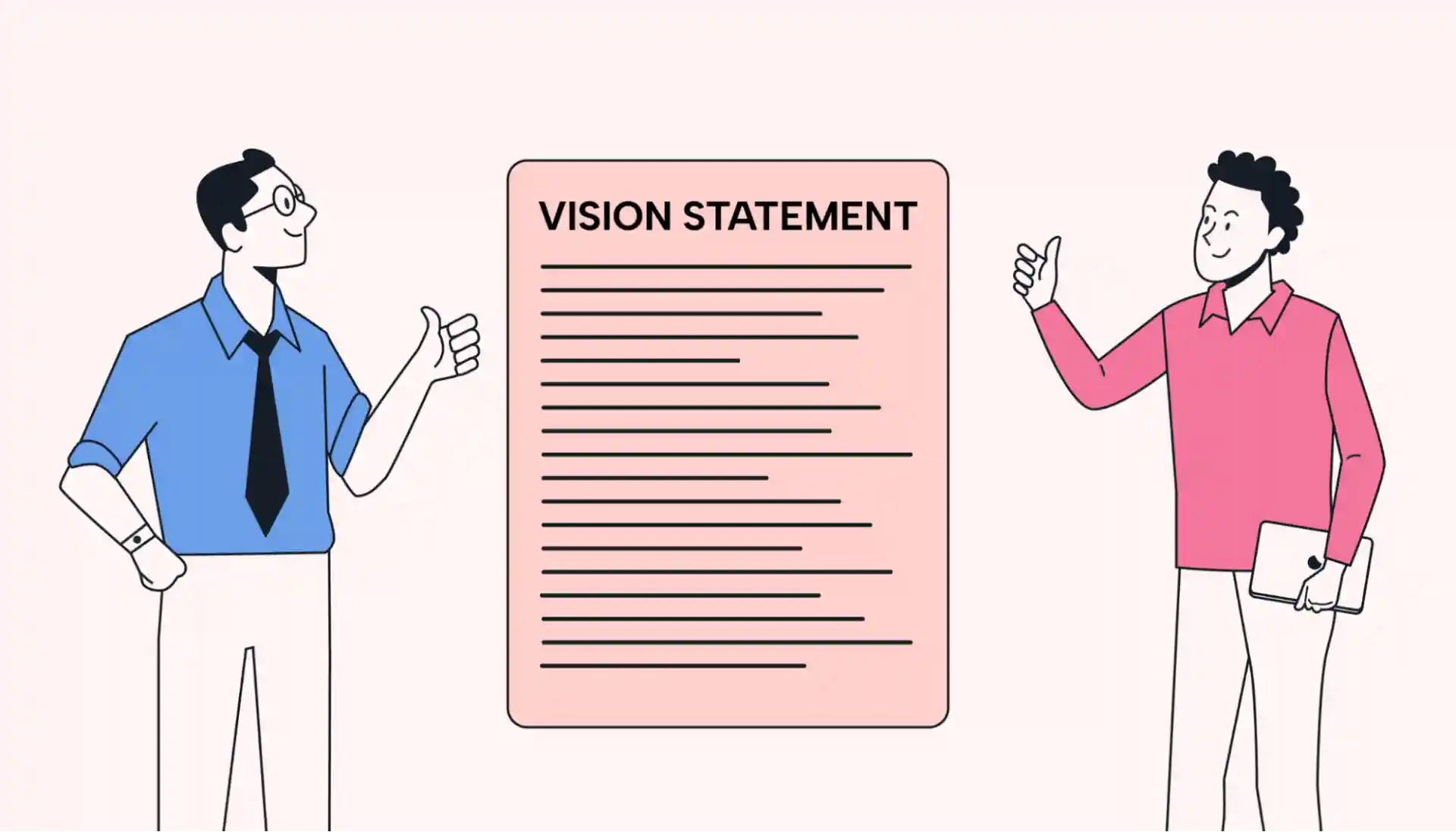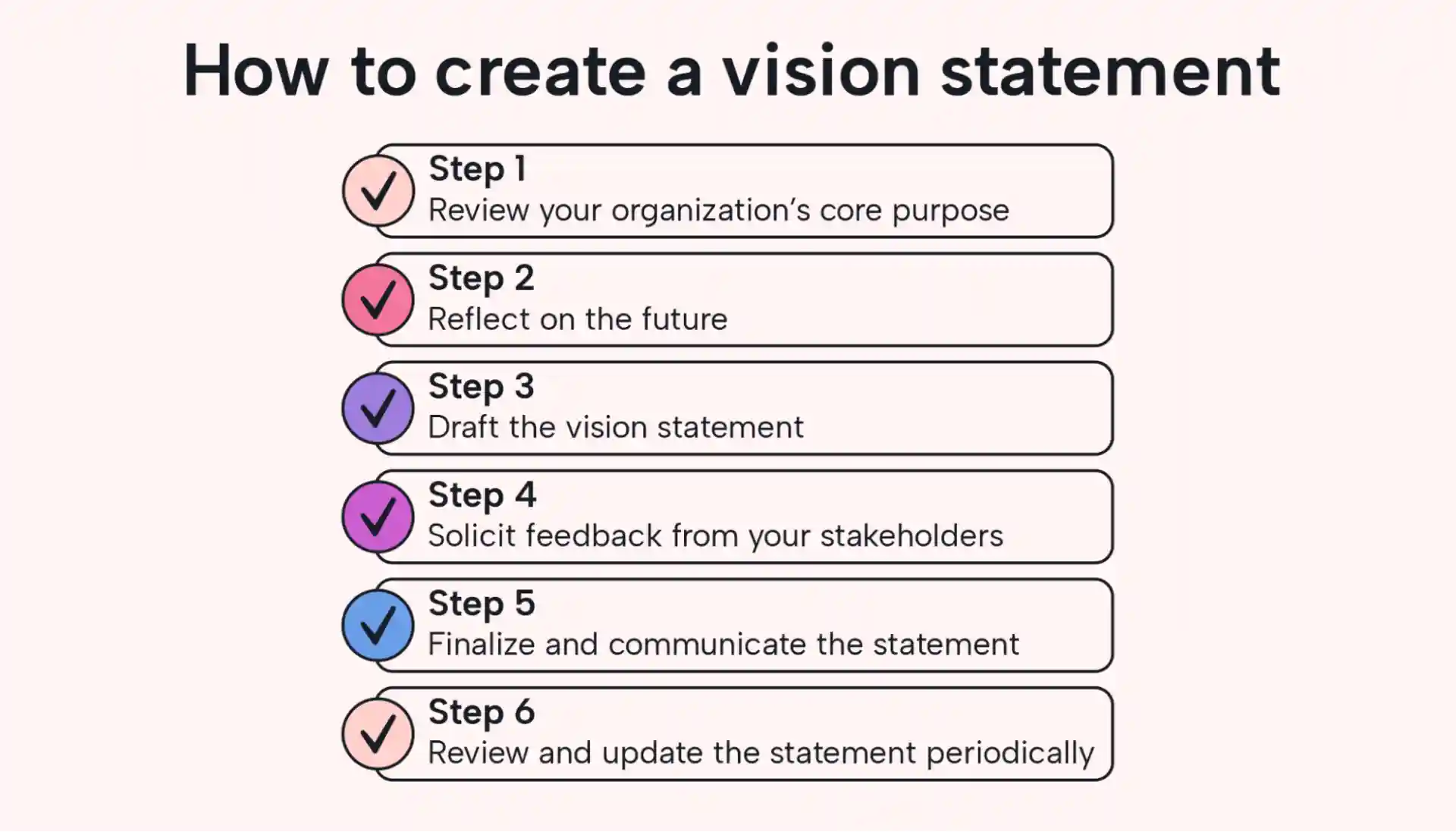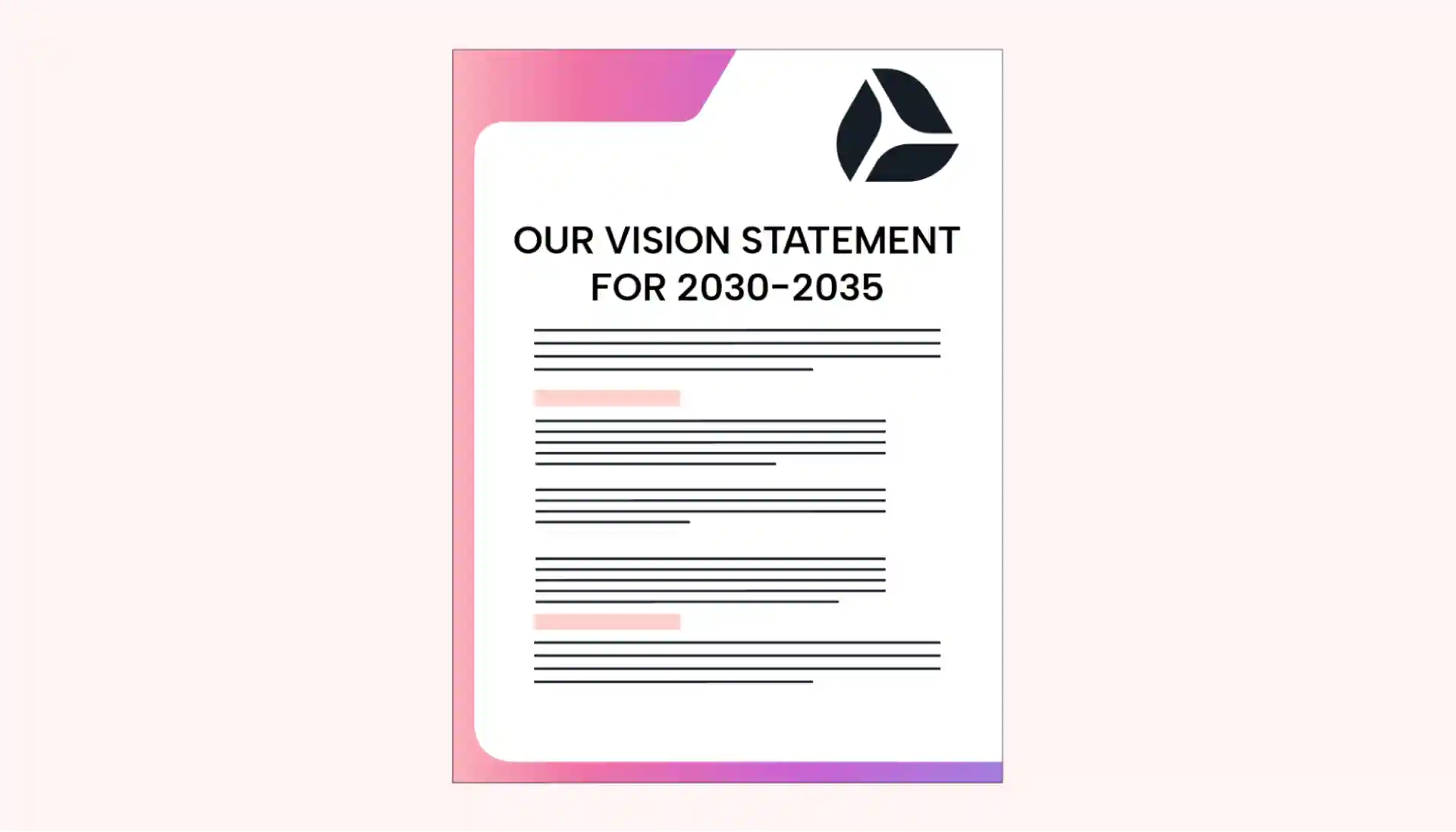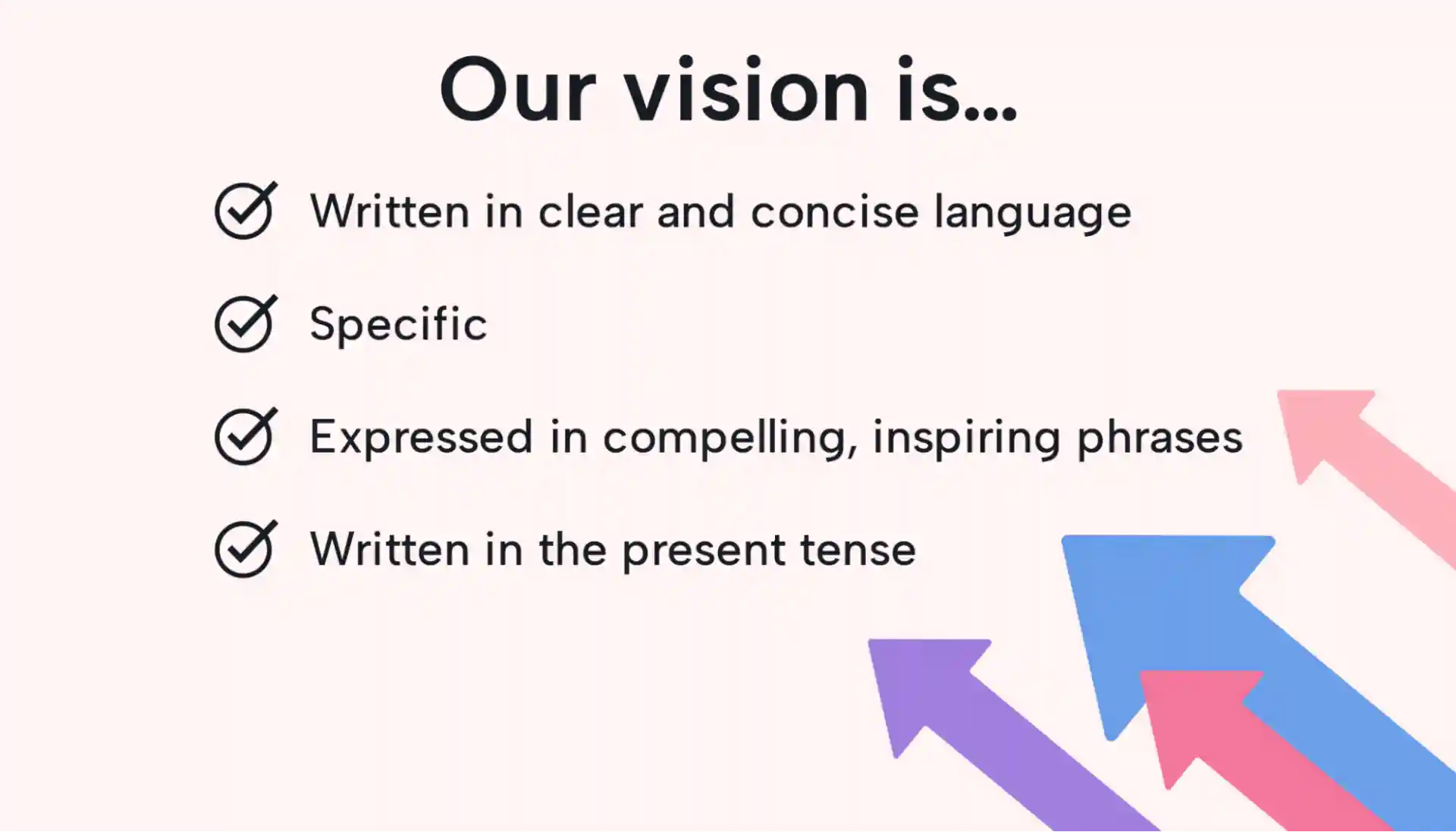Many companies have corporate mission statements. But a mission statement alone may not be enough to inspire a workforce to give their best every day. After all, even the loftiest mission phrases can get stale without an eye on the future.
That’s where a corporate vision comes in.
A vision statement encapsulates a business’s mission with powerful imagery and compelling goals that propel the business toward a positive future.
Read on to learn more about the benefits of corporate vision statements, how to maximize their usefulness for your business, and how to compose your own.
What is a corporate vision statement?
A corporate vision statement is a formal sentence or paragraph that a company or organization uses to describe its long-term goals and aspirations.
Vision statements are typically forward-looking. They serve as a guide for the company’s future direction and describe its impact on society in general or on subgroups as it embodies its core values and purpose.
Vision statements build on mission statements. Mission and vision statements are related and can both improve organizational performance. However, they serve different purposes.
A mission statement describes a company’s reason for being, including the main goal or goals it wants to accomplish and the beneficiaries. In contrast, a vision statement describes a desired future state brought about as the company pursues and fulfills its mission.
The intent of a vision statement is to inspire employees and stakeholders by portraying a compelling image of what the company wants to achieve as it moves toward the future. A well-crafted, vivid one can motivate people to work toward that future.
 |
What are the benefits of having a corporate vision?
Corporate visions aren’t just token statements. They offer benefits that can lift everything from employee engagement to revenue. Here are some of the most important ones:
1. Guidance and direction
A vision statement provides clear direction for a company’s future when it’s used to guide strategic planning and decision-making processes. It helps align the organization’s efforts and resources with its biggest goals.
2. Inspiration and motivation
A vision statement conveys an aspirational future to inspire and motivate employees. It can generate a shared sense of purpose and commitment to achieving the company’s objectives.
3. Brand identity and reputation
A well-crafted vision statement helps build a strong brand identity. It communicates the company’s values and aspirations to customers, investors, and the public at large.
4. Employee alignment and engagement
A vision statement helps to align employees’ personal goals with the company’s objectives. This can lead to increased employee engagement, productivity, and job satisfaction.
5. Decision-making framework
A solid vision statement offers a framework for decision-making that ensures business choices are consistent with the company’s long-term objectives and values.
6. Attracting talent and investors
A compelling vision statement can attract top talent and investors who share the company’s values and are enthusiastic about its prospects.
 |
7. Innovation and growth
A well-written vision statement encourages innovation by setting a lofty goal that challenges the status quo and promotes growth and development within the company.
8. Competitive advantage
A clear vision statement can provide a competitive advantage by differentiating the company in the marketplace and appealing to customers who identify with its long-term aspirations.
9. Adaptability and resilience
In times of change or crisis, a vision statement can provide a stable reference point. It can help the company adapt and remain resilient while staying true to its core aspirations.
10. Increased stakeholder confidence
An inspiring vision statement helps build confidence among stakeholders, including shareholders, customers, and partners, by demonstrating the company’s commitment to a purposeful and sustainable future.
With all these benefits, it’s wise for any company to create its own vision statement.
Here’s how to do just that.
6 steps for crafting a stellar corporate vision
How do you create a compelling vision statement for your company or organization? Follow the six detailed steps below to draft an inspiring statement and integrate it firmly into your company culture.
 |
Step 1. Review your organization’s core purpose
Begin by revisiting your company’s core purpose. This will act as the foundation for your vision.
You may already have your company’s purpose expressed in a mission statement, but it’s still a good idea to review it in your pursuit of a long-term vision statement.
Step 2. Reflect on the future
Determine where your company currently stands in terms of implementing its mission.
Also, look at market trends, customer needs, and any emerging technologies that can or will likely influence your company’s mission as you push into the future.
Ask yourself:
- Where would you like the company to be in 5 to 10 years?
- What is the gap, if any, between your current situation and this ideal future position?
- How will you feel when your company reaches that ideal point in the future? Happy? Satisfied? Or like you’ve only reached your first milestone, and there’s much more to come?
Use your answers to these questions to help you draw up a list of components to include in your vision statement.
Step 3. Draft the vision statement
Use the data you collected in Steps 1 and 2 to draft a compelling vision statement that depicts the future you see for the company. As indicated in Step 2, a good time frame for that vision is 5 to 10 years out.
Your vision statement can take the form of a simple declaration that confirms that ideal future state, such as, “Our company [X] is the premier provider of [Y] in every state in the US and every province in Canada.”
It can also take the form of a more elaborate statement that paints a detailed picture of the foreseeable future. For example:
“TerraGreen Innovations revolutionizes the global energy landscape by envisioning a sustainable future. A decade from now, we are the leading provider of eco-friendly energy solutions that drastically reduce carbon footprints worldwide. Our commitment is to harness cutting-edge technology for creating renewable energy sources and making clean power accessible and affordable to all to create a healthier planet for future generations.”
Whichever formula you choose, make sure the statement is clear and specific enough to align with your company’s mission and provide operational direction. Ultimately, a compelling vision statement should become the driving force behind your company’s daily efforts.
As you put the components of your vision statement into a draft, make sure to ask yourself if what you are envisioning is actually doable. If not, adjust the unrealistic elements or the time frame.
Step 4. Solicit feedback from your key stakeholders
Since the vision statement you are creating is meant to inspire the whole company, you should involve stakeholders, including employees, management, customers, and possibly even important shareholders, in the process. Their insights and perspectives will ensure the vision resonates throughout the organization.
To get quality feedback, ask a few targeted questions as you distribute the draft, such as:
- “On a scale of 1 to 10, how well does this vision statement draft reflect your sense of the organization’s future?”
- “Does this vision statement inspire you? In what ways?”
- “If you could improve one thing in this vision statement, what would it be?”
 |
Step 5. Finalize and communicate your vision statement
Finalize the statement by incorporating the feedback you received from your stakeholders.
Next, communicate the statement across the organization. Here are some suggestions for doing this:
- Formally roll out the vision statement in a company-wide meeting.
- Have the statement printed out on special paper, and present each employee with a hard copy they can keep at their desk.
- Have the employees regularly review the vision statement until it becomes ingrained in their daily operations.
It’s good practice to make the vision part of your company’s corporate culture by ensuring it’s reflected in all aspects of your operations, from strategic planning to daily decision-making. For instance:
- Incorporate it into your website.
- Use it regularly in company newsletters and marketing materials.
- Embed it in your annual business plan.
Step 6. Review and update the statement periodically
A vision statement is not set in stone. As your company grows and the business environment changes, periodically revisit and update your statement so that it remains relevant and inspiring.
And once your vision has become a reality, consider drafting a new iteration as a stretch goal for the next business phase.
 |
Examples of corporate vision statements to inspire you
Many well-known businesses and organizations have written vision statements to inspire readers about the future they envision for their companies and the impact they’d like their companies to have on the world at large.
Below are 10 examples of vision statements from both the business and the non-profit worlds.
“To be the world’s most loved, most efficient, and most profitable airline.”
“A world where the diversity of life thrives, and people act to conserve nature for its own sake and its ability to fulfill our needs and enrich our lives.”
“We will build a new medium that will redefine and enhance the nature of spoken information, education, entertainment, and other modes of verbal expression we will help create ourselves.”
“A world where everyone has a decent place to live.”
“By 2030, Target aims to be the market leader for creating and curating inclusive, sustainable brands and experiences.”
Shell (a vision statement specifically for its commitment to diversity and inclusion)
“Our vision is a bold one — to become one of the most diverse and inclusive organizations in the world. A place where everyone (from employees, to our customers, partners and suppliers) feels valued, respected and has a strong sense of belonging.”
“Through our unparalleled collections and research capabilities, and the insight and creativity we foster through art, history, and culture, the Smithsonian strives to provide Americans and the world with the tools and information they need to forge Our Shared Future.”
“Provide the world’s best customer experience every day.”
“To inspire tomorrow’s creators to use technology to build brighter futures for themselves, their families and the world.”
“To make the movement and management of money as simple, secure, and affordable as possible.”
Tips for writing compelling vision statements
In this section, you’ll find some helpful tips to make your corporate vision statement truly memorable and inspiring.
 |
Be concise and clear
As seen above, vision statements can range in length from one or two sentences to longer, descriptive paragraphs.
In either case, your writing should be pointed and concise (avoid long, flowery essays, as these are hard to remember and can confuse readers).
Be specific
Avoid vague statements that could apply to any company.
Here’s an example of a generic vision: “Over the next 10 years, our company will have made a big difference in the lives of millions.”
An alternative with detailed, specific components could look like this: “In 10 years, our [product, technology, solution] is being used daily by 30 million households in the US.”
Use compelling language
Whether your statement is short or long, craft it with inspiring, forward-looking language that reflects your company’s aspirations.
To make your vision statement compelling, use descriptive words and phrases that convey strong images or carry emotional overtones. This is easier for readers to remember, and they’ll be more motivated by the vivid language.
For instance, rather than saying, “20 million users interface with our technology daily for their communication needs in the senior demographic,“ say, “20 million people use our technology daily to connect heart-to-heart with aging friends and loved ones.”
Claim your vision now
Since a vision statement looks toward the future, it might seem logical to formulate it in the future tense — as in “A decade from now, we will be the foremost medical diagnosis software company in the world.”
However, one of the functions of a strong vision statement is to bridge the gap between the present and the future.
To accomplish this, write your statement in the present tense, as if the vision is already happening. For instance, “In 2034, we are the foremost medical diagnosis software company in the world.”
A strong affirmation like this draws your future vision into your present reality.
Make your vision statement come alive with Motion
When done well, a corporate vision statement is a powerful driving force behind a company’s success — but it needs to be woven into everyday projects for its motivational power to be activated.
A good way to do this is to break your vision statement down into its various components and input these into an intelligent project management tool like Motion. This will keep these components at the forefront of everyone’s minds in your company.
To discover the power of this smart approach to your vision statement implementation, try Motion for free for 7 days.

A certified content writer and SEO strategist, Carla Groenewegen writes about success principles and practices aimed at SMBs and not-for-profit organizations.





